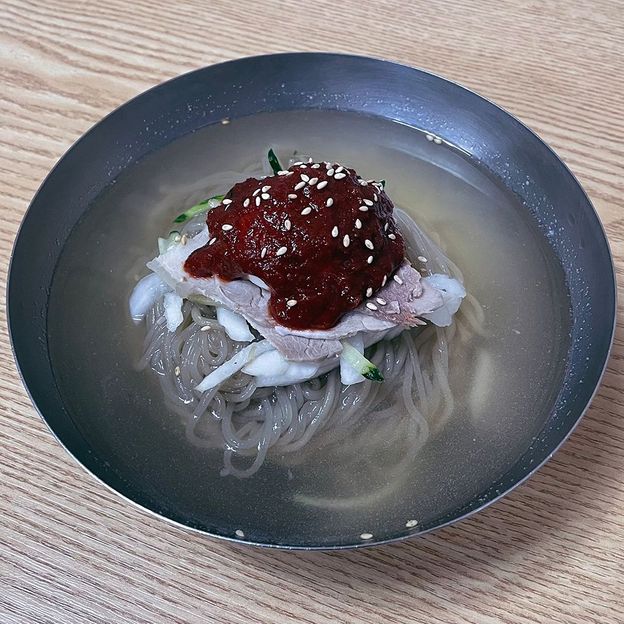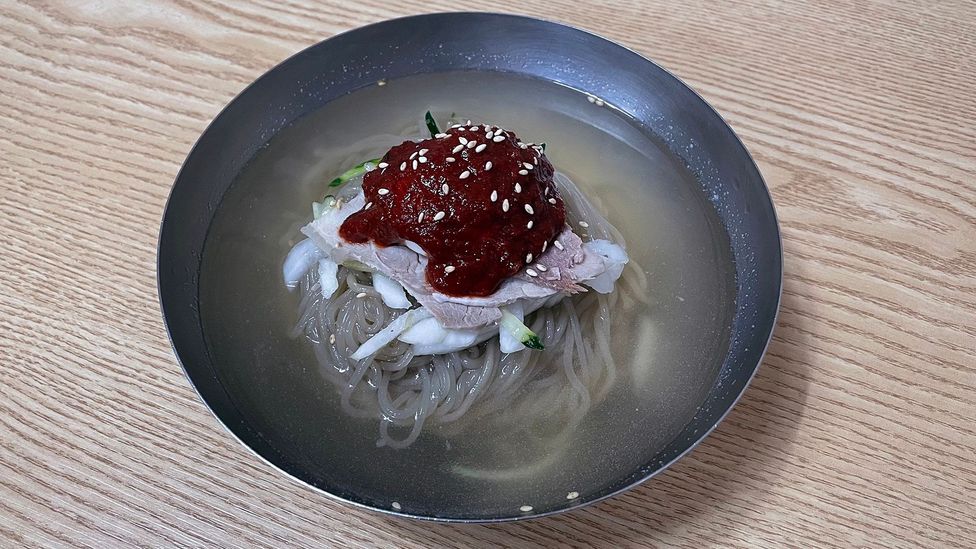Busan, South Korea's second-largest city, is coming into the culinary spotlight: Michelin recently announced that it will be including the southern port city for the first time in their 2024 guide (released in February 2024).
The city has a vibrant food scene that is steeped in history, and many locals know that if there is one dish that is most deeply entrenched in the fabric of the city, it's milmyeon: a dish of wheat noodles served in a chilled broth.
Milmyeon, shortened from mil (wheat) and naengmyeon (cold noodles), came about as a result of the Korean War (1950-1953). Many of those who fled from regions now in North Korea and settled in Busan started to cook a version of naengmyeon, a cold buckwheat noodle soup that is a specialty of North Korea. Yet with limited access to buckwheat due to the war, they eventually started making their noodles with wheat flour, one of the abundant war supplies provided by the US army based in Busan. Thus, North Korean naengmyeon morphed into South Korean milmyeon.
Today, milmyeon is a sought-after Busan speciality. The wheat flour noodles have a pleasant, chewy texture, and are served with cold beef (or pork) broth poured over them. The bowl is topped with strips of fresh cucumber or lightly salted radish and half a boiled egg. A scoop of spicy sauce made with gochugaru (ground Korean chilli powder) is a must, and variations include strips of fried egg or even using spring water from local mountains to make the broth.
Among the many milmyeon joints that popped up in Busan during the war, Naeho Naengmyeon in Busan's Nam-gu neighbourhood is widely perceived as a pioneer. Chef and owner Yoo Jae-woo is the fourth generation to run the restaurant, which was founded by his great grandparents in 1919 in North Korea's Naeho village in Hameung province.
After fleeing from North Korea to Busan during the war, Yoo's great grandparents opened what they thought would be a temporary outpost of Naeho Naengmyeon in 1953, selling North-Korean style naengmyeon. They named the restaurant "Naeho" after their home village to continue the legacy of their family business. "I heard [my] great grandparents kept every recipe as true to the original they had made before fleeing, thinking that they [would be] going back home after," said Yoo.
However, in 1953, the border between North and South Korea was closed and they couldn't return. In 1956, their children took over the business and rejigged the noodle recipe, making their naengmyeon with a combination of wheat flour and sweet potato starch, which were easier to obtain and considerably less expensive.
"It was a comfort food for many labour workers around the Busan Harbour looking for a quick yet fulfilling meal for the day," said Yoo. "[The workers] were regulars for decades [and] kept the business going and helped Busan become the city of milmyeon. And now travellers from elsewhere in Korea or other countries come to try the noodles to experience a piece of history made in Busan."
Milmyeon noodles served at Naeho today are thicker and chewier than any other milmyeon in Busan, because they're made with 70% wheat flour and 30% sweet potato starch. The high ratio of inexpensive wheat flour keeps the cost of making the noodles low, making milmyeon as affordable today as it was during and just after the war.
With Michelin's recent announcement, the spotlight on milmyeon has intensified. Restaurants are now getting their menus translated into English and other languages to help foreigners with ordering. Locals and expats alike are on the hunt to find their favourite milmyeon, while the global community turns its head to discover this new culinary hotspot.

The chilled milmyeon at Naeho Naengmyeon are topped with spicy sauce (Credit: Summer Lee)
Ingredients
For the broth:
5kg (11lb) beef bones
400g (14oz) beef skirt or shank
5 small cloves of garlic
10g (about 1½ tsp) fresh ginger
2 spring onions
5 litres (5qt) water
For the sauce:
3 tbsp gochujang
1 tbsp starch syrup or corn syrup
1 tsp minced garlic
1 tsp minced spring onion
For the noodles and garnish:
500g (1.1lb) radishes, cut into matchsticks
2 tsp salt
2 tbsp white vinegar
1 egg
one pack of jjolmyeon noodles (see Note)
½ cup cucumber, cut into matchsticks
Method
Step 1
Soak the beef bones and beef in cold water 10-12 hours in the refrigerator to drain any residual blood. Change the water every 2-3 hours or as often as possible when water turns pink.
Step 2
To make the sauce, mix all the ingredients in a small bowl. Cover and refrigerate overnight.
Step 3
Drain the beef bones and beef and put in a large pot with the garlic, ginger, spring onions and 5 litres of water. Bring to a boil, then boil over medium heat for about 15 minutes. Take out the bones and beef and thinly slice the meat to use later as a garnish; refrigerate the meat. Let the broth cool, then refrigerate it.
Step 4
Place the radishes in a bowl and add the salt and vinegar. Mix well and leave for about 20 minutes. Drain any water and transfer to a new bowl.
Step 5
In a pot of boiling water, cook the egg for 13 minutes. Take out the egg and place in cold water for about 3 minutes to cool down. Peel the cooked egg and cut in half; set aside.
Step 6
Lightly rinse the noodles in a bowl of water to separate them, then cook in boiling water according to the package directions for 2 servings. When the noodles are cooked, rinse them in cold water and drain.
Step 7
Place the noodles in the centre of 2 serving bowls. Top with 2 to 3 slices of beef, the cucumber and some of the radish. Top with the sauce, then set the egg in the sauce. Pour the cooled broth into the bowl. Put the remaining radish on a plate and serve on the side as a banchan (a Korean term for small dishes that are served together).
Tip
There will be broth left over, which can be frozen for up to 1 month.
Note
Look for pre-made jjolmyeon noodles, which are made from a combination of wheat and starch and are most similar to the homemade noodles at Naeho Naengmyeon. If they are unavailable, spaghetti noodles or jungmyeon (regular size wheat noodles) can be used, but the texture will be different. Slightly undercook the spaghetti or jungmyeon noodles so that they are not too soft.
BBC.com's World's Table "smashes the kitchen ceiling" by changing the way the world thinks about food, through the past, present and future.
---
Join more than three million BBC Travel fans by liking us on Facebook, or follow us on Twitter and Instagram.
If you liked this story, sign up for the weekly bbc.com features newsletter called "The Essential List". A handpicked selection of stories from BBC Future, Culture, Worklife and Travel, delivered to your inbox every Friday.
